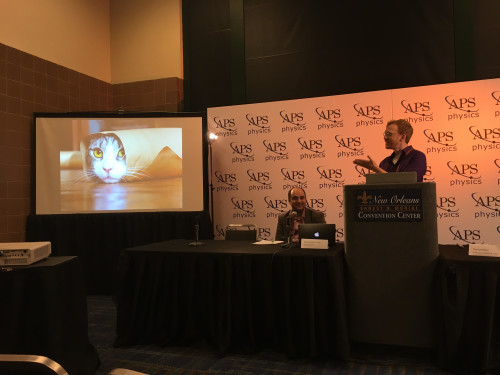
Cats and DFT: Thomas Baker chats about machine learning and density functional theory. (Courtesy: Sarah Tesh)
By Sarah Tesh in New Orleans, Louisiana, US
So the first day of the APS March Meeting has been and gone and the second is nearly at an end. Being my first conference as a journalist not a scientist, I was definitely as nervous as some of the speakers looked. The conference centre is huge, there are thousands of people and almost as many talks – a rather daunting prospect for a newbie. Thankfully there were some very interesting press talks, covering a variety of topics.
The first session began with Jay Fineberg from the Hebrew University of Jerusalem in Israel talking about “friction as fracture”. While we all learn about friction at school, the fundamental physics behind it remains shrouded in mystery. So Fineberg looks at the problem as the fracture of contact points. This approach makes it particularly useful for studying the motion of tectonic plates and, so, earthquakes. As Fineberg points out, seismologists have no idea about conditions deep in the ground at a fault. He and his team therefore hope to work out “what makes earthquakes tick”.
Next, we had Zhiyue Lu of the University of Chicago in the US discussing the Mpemba effect. This is when hot water freezes faster than cold water. As another long-standing mystery in physics, there seem to be a variety of reasons why this could happen, and Lu’s team is keen on coming up with a general theory for the effect. By imagining the two temperatures as cars going along a “temperature highway”, Lu points out that by Newton’s heat law, the cold car should reach freezing before the hot car. He calls this the “curse of the 1D effect” – only considering one degree of freedom, i.e. temperature. Instead, other degrees need to be introduced and the hot car can then take a short cut (as a flying car in this anology) to freezing temperatures. The shortcut can be explained by studying the “energy landscape” of the system – this is where more degrees of freedom come into play – which shows that the cooler temperatures sit in energy wells while the hotter ones do not, and can therefore reach the freezing point quicker.
Another highlight was Thomas Baker from the University of California, Irvine in the US. As soon as I saw his second slide – a cat in a paper roll – I was a fan. Baker uses machine learning – such as how your browser learns that you watch cat videos to tailor its suggestions – to improve density functional theory (DFT). “The machine learning techniques are a very promising route to accessing the exact physics that can be found from DFT, instead of the nearly 30,000 papers published each year that use approximations to this form and get approximate answers,” said Baker. He hopes that the combination could allow new molecules and materials to be designed.
George Malliaras from l’École des Mines de Saint-Étienne in France presented his work on brain implants for treating drug-resistant epilepsy. Currently, when drugs cannot penetrate the blood–brain barrier, treatment options are highly invasive. For example, electrodes can be inserted into the brain to detect neural signals, allowing doctors to locate the source of the seizures. That part of the brain is then removed – naturally a very dangerous process, especially if it’s located near a vital area of the brain. Malliaras and team are therefore developing organic brain implants that can release dry drugs directly to the problem area. They hope that the devices could be applied to humans in the next couple of years and may also have applications for treating Parkinson’s disease.
Guidelines
Show/hide formatting guidelines
this text was deletedwhere people live in harmony with nature and animals</q>
Some text